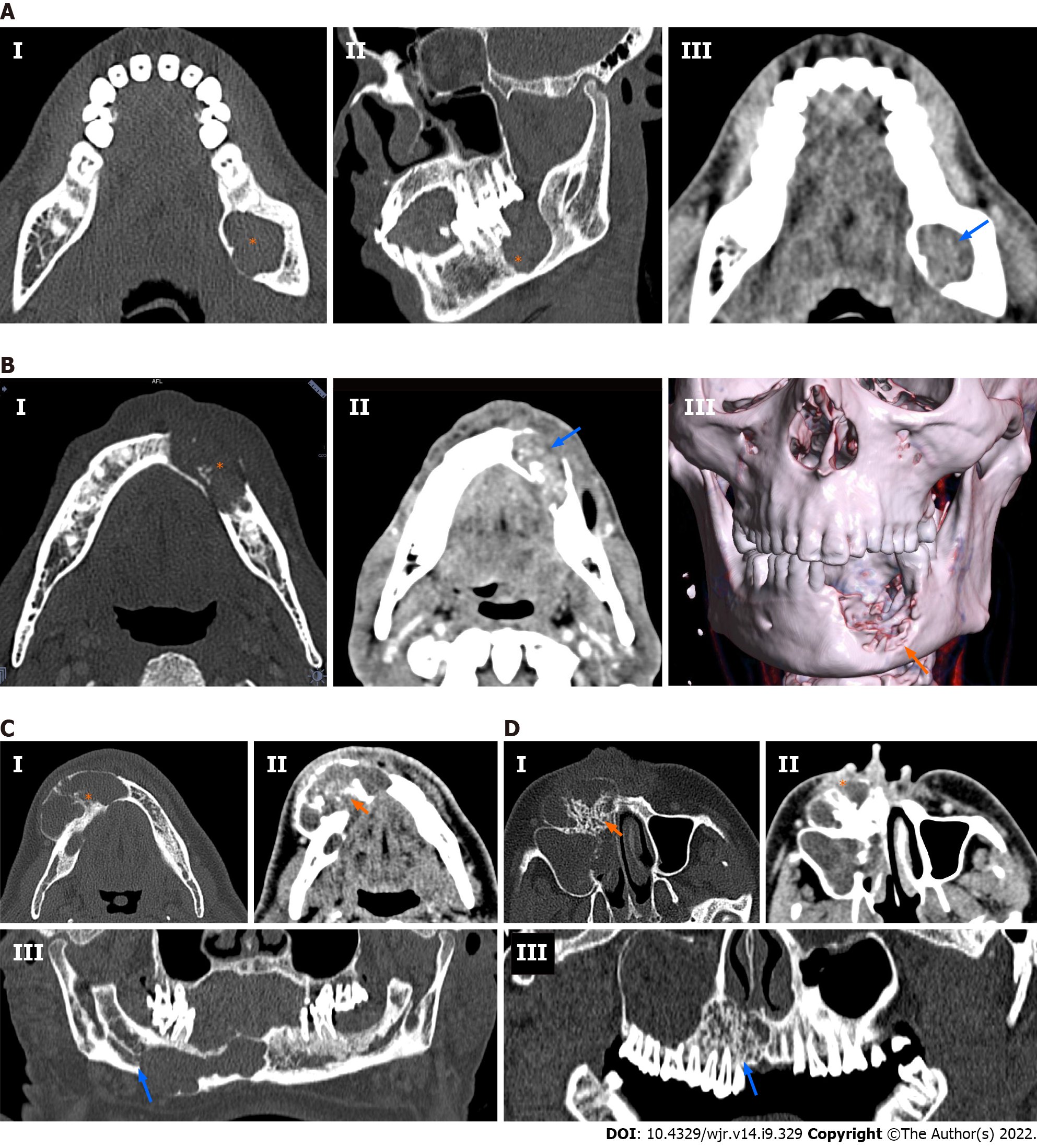Copyright
©The Author(s) 2022.
World J Radiol. Sep 28, 2022; 14(9): 329-341
Published online Sep 28, 2022. doi: 10.4329/wjr.v14.i9.329
Published online Sep 28, 2022. doi: 10.4329/wjr.v14.i9.329
Figure 1 Location of every lesion was classified into the following zones: 1, limited to the incisors; 2, limited to the canine and premolars; and 3, limited to the molars and posterior mandible.
A similar classification was applied to the maxilla. Lesions extending over multiple zones were classified as such, and a suffix of R or L was used to denote right or left-sided location. When the lesion crossed the midline across multiple zones, + was used to denote the same.
Figure 2 Spectrum of multidetector computed tomography findings in central giant cell granulomas.
A: 35-year-old woman presented with upper facial pain and nasal obstruction. Cone beam computed tomography (CBCT) shows a left-sided unilocular lytic lesion arising from the left maxilla (Panel I: Bone window) with compression of the maxillary sinus. Mineralised matrix was scattered in the substance of the tumour (asterisk). The lesion showed a significant soft tissue component, which enhanced to an extent greater than the surrounding muscles [arrow, Panel II and III: Axial and curved multiplanar reconstructed (MPR) coronal soft tissue images]. Hyperenhancement of the soft tissue tumour component was highly suggestive of a prospective central giant cell granuloma (CGCG) diagnosis; B: A 30-year-old man presented with pain and upper jaw swelling, contrast-enhanced computed tomography (CECT) showed a lytic sclerotic, multilocular mass arising from the maxilla with the presence of incomplete septae (asterisk) with mineralised matrix (Panel I: Axial bone window). Significant solid soft tissue component with enhancement greater (arrow) than the surrounding muscles was also noted (Panel II: Axial soft tissue window images). Curved MPR images (Panel III: Bone window) showed resorption of the roots (empty arrow) and floor of the nasal cavity; C: A 24-year-old woman presented with progressive jaw swelling over the last 6 mo, with intermittent pain. CECT showed a sclerotic lytic lesion with a honeycomb appearance (Panel I: Axial bone window) arising from the mandible. The lesion showed thick bony septae with mineralised matrix (asterisk). The associated soft tissue component showed enhancement similar to the surrounding muscles (orange arrow: Panel II: Axial soft tissue window). The tumour (blue arrow) can be seen encroaching onto the distal end (#) of the left inferior alveolar canal (Panel III: Curved MPR bone window).
Figure 3 Spectrum of multidetector computed tomography findings in ameloblastoma.
A: A 30-year-old man presented with progressive left lower jaw swelling. Cone beam computed tomography (CBCT) showed a unilocular, lytic lesion (asterisk) with no septae involving the left angle of the mandible (Panel I and II: Axial and coronal bone window). The soft tissue component showed enhancement similar (blue arrow) to the surrounding muscles (Panel III: Axial soft tissue window); B: A 52-year-old man with lower mid jaw pain and swelling; contrast-enhanced computed tomography (CECT) showed a sclerotic, lytic multilocular lesion with thin incomplete septae (asterisk) and associated mineralised matrix (Panel I: Axial bone window). There was a significant soft tissue component showing enhancement (blue arrow) similar to the surrounding muscles (Panel II: Axial soft tissue window). Erosion of the buccal cortex was seen in three-dimensional volume-rendered images (Panel III); C: A 53-year-old man with painful progressive lower jaw swelling of 7 mo duration. CECT showed a lytic sclerotic multilocular mandibular mass with multiple thick septae (asterisk), cortical expansion and breach (Panel I: Axial bone window). The solid component present in the tumour showed hypoenhancement (arrow) compared to the surrounding muscles (Panel II: Axial soft tissue window). Hypoenhancing soft tissue was characteristically not seen in central giant cell granulomas, allowing a prospective diagnosis of ameloblastoma. Erosion of the right canal of the inferior alveolar nerve (blue arrow) was clearly seen [Panel III: Curved multiplanar coronal reconstruction (MPR), bone window]; D: A 42-year-old man with upper maxillary swelling and significant malar pain. CECT showed a lytic sclerotic mass with honeycombing (orange arrow) and thick bony septae (Panel I: Axial bone window). There was significant cortical expansion with extension into the right maxillary sinus. The mass was predominantly lytic with minimal solid component (asterisk) seen in the mass, hypoenhancing compared to the surrounding muscles (Panel II: Axial soft tissue window). Erosion of the roots (blue arrow) with honeycomb appearance was visible (Panel III: Curved MPR coronal bone window).
- Citation: Ghosh A, Lakshmanan M, Manchanda S, Bhalla AS, Kumar P, Bhutia O, Mridha AR. Contrast-enhanced multidetector computed tomography features and histogram analysis can differentiate ameloblastomas from central giant cell granulomas . World J Radiol 2022; 14(9): 329-341
- URL: https://www.wjgnet.com/1949-8470/full/v14/i9/329.htm
- DOI: https://dx.doi.org/10.4329/wjr.v14.i9.329











